Your trip to Norway wouldn’t be complete without time spent exploring the country’s stunning fjords. And because these long, narrow, saltwater inlets make up much of Norway's coastline, you'll have plenty to choose from.
But what makes Norway’s fjords so special? Well, it’s that here you can feast your eyes on some of Scandinavia’s most jaw-dropping scenery.
Read on to find out why you should visit the best fjords in Norway. Get ready to ignite your wanderlust!
- Prepare for adventure on one of these Norway fjord tours
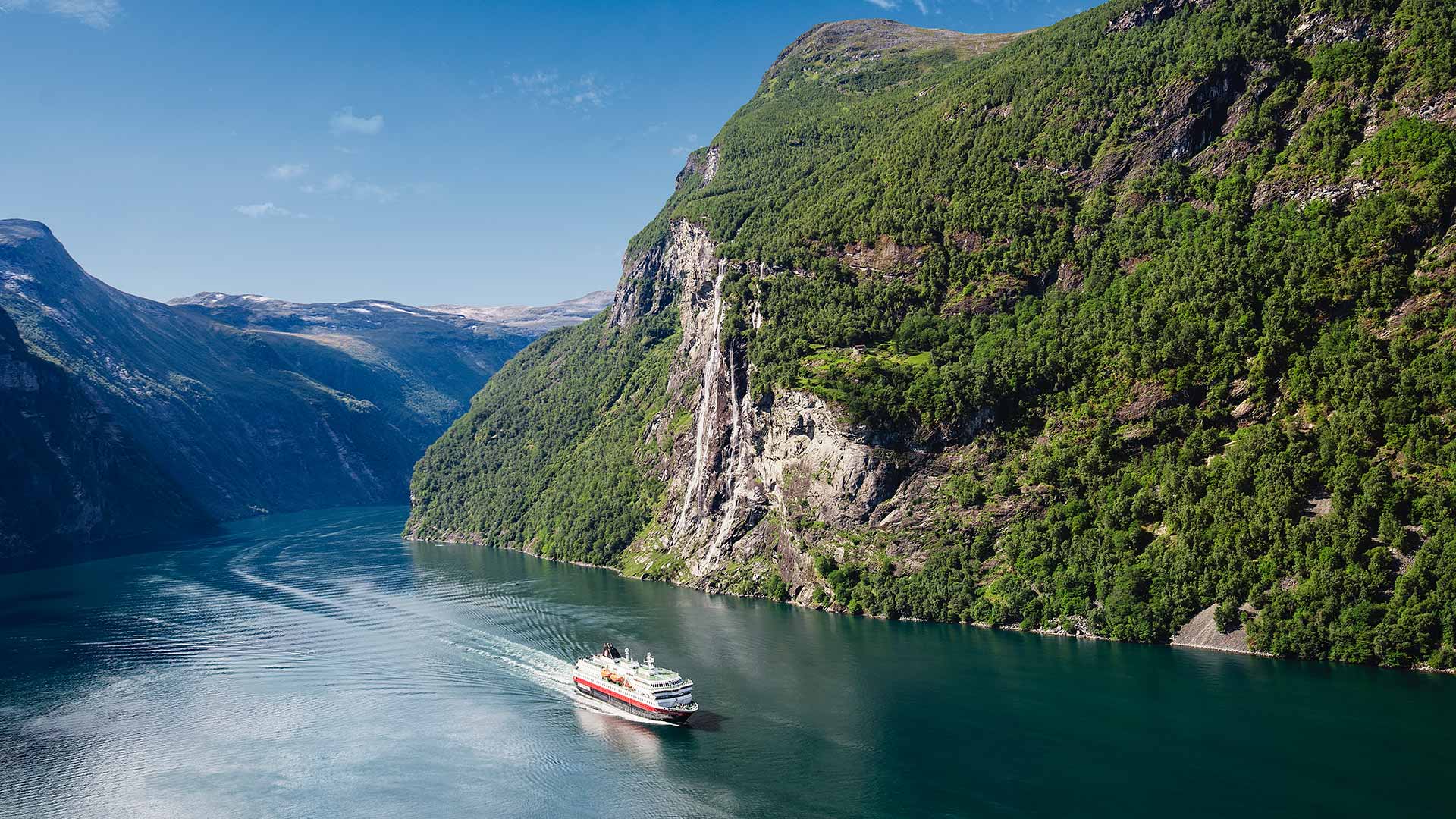
1. Geirangerfjord
Geirangerfjord is a UNESCO World Heritage Site, and arguably the most famous fjord on the planet. Known for its deep blue waters, towering mountain peaks and abundant waterfalls, Geirangerfjord is the place to go for striking scenery.
Plus, there are plenty of opportunities for sightseeing and outdoor activities, such as hiking and kayaking, in the surrounding area. For instance, head to the Geiranger Skywalk, a platform rising 1500 metres (4,920 feet) above sea level, and you’ll get unrivalled views of the fjord.
More breathtaking views await if you follow the winding Eagle Road up to Ørnesvingen lookout point. From here visit the Norwegian Fjord Centre where you’ll learn about how these landscapes were formed.
A Norway summer tour is a great way to experience Geirangerfjord at its most lush. Travel from May to September, and you’ll also benefit from the year’s best weather.
Another reason to visit during the summer months is that you’ll be able to take the ferry from Geiranger to Hellesylt. The latter is a tiny village that’s home to the oldest Viking port in Norway, so it’s well worth a visit.
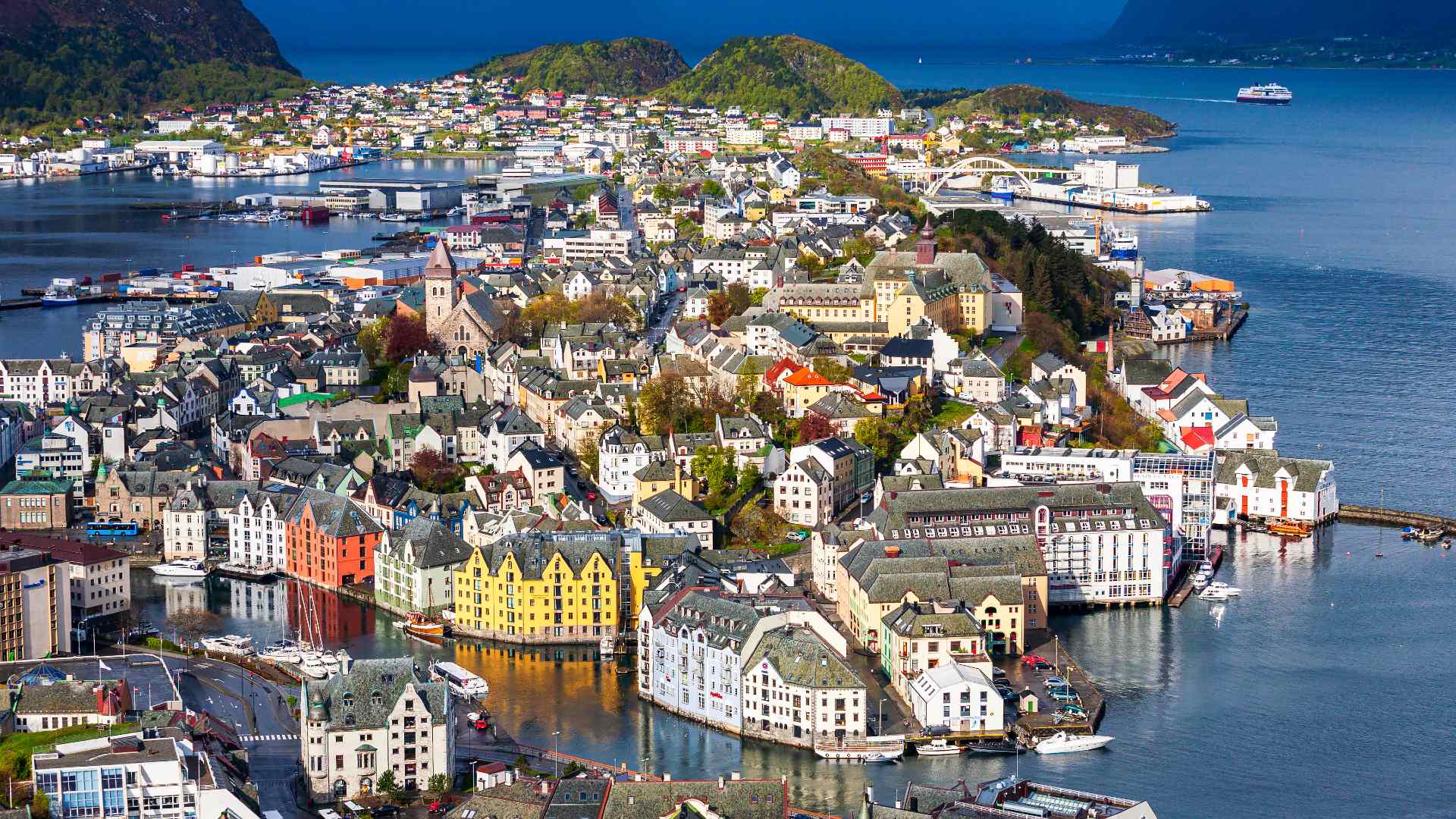
How do I get to Geirangerfjord?
First, head to one of these nearby transport hubs, from where you can travel onto Geirangerfjord:
- Ålesund Airport – daily flights departing from Oslo, Bergen and Trondheim
- Åndalsnes Railway Station – daily trains departing from Oslo and Trondheim
Once you’ve arrived in Ålesund or Åndalsnes, there are a number of ways that you can get to Geirangerfjord.
By bus: Bus connections from Ålesund operate year-round. But there are more direct routes available in the summer, which also incorporate the car ferry between Hellesylt and Geiranger.
In June, July and August, bus links run from Åndalsnes to Geirangerfjord directly. Throughout the rest of the year, it’s possible for you to take a bus to Ålesund, before connecting to Geirangerfjord.
By ferry: From April to October, you can hop aboard a direct ferry from Ålesund to Geirangerfjord.
By car: If you’re renting a car for your trip, it’s easy to drive to Geirangerfjord from Ålesund or Åndalsnes in summer. This is because the mountain roads, including the Trollstigen (aka the Troll Ladder), are open.
Bear in mind that road access is limited from November to May as large sections are closed over the winter months.
- Take a holiday to Norway and you could see Geirangerfjord and more
- Related: What to see and do in Norway’s Geirangerfjord
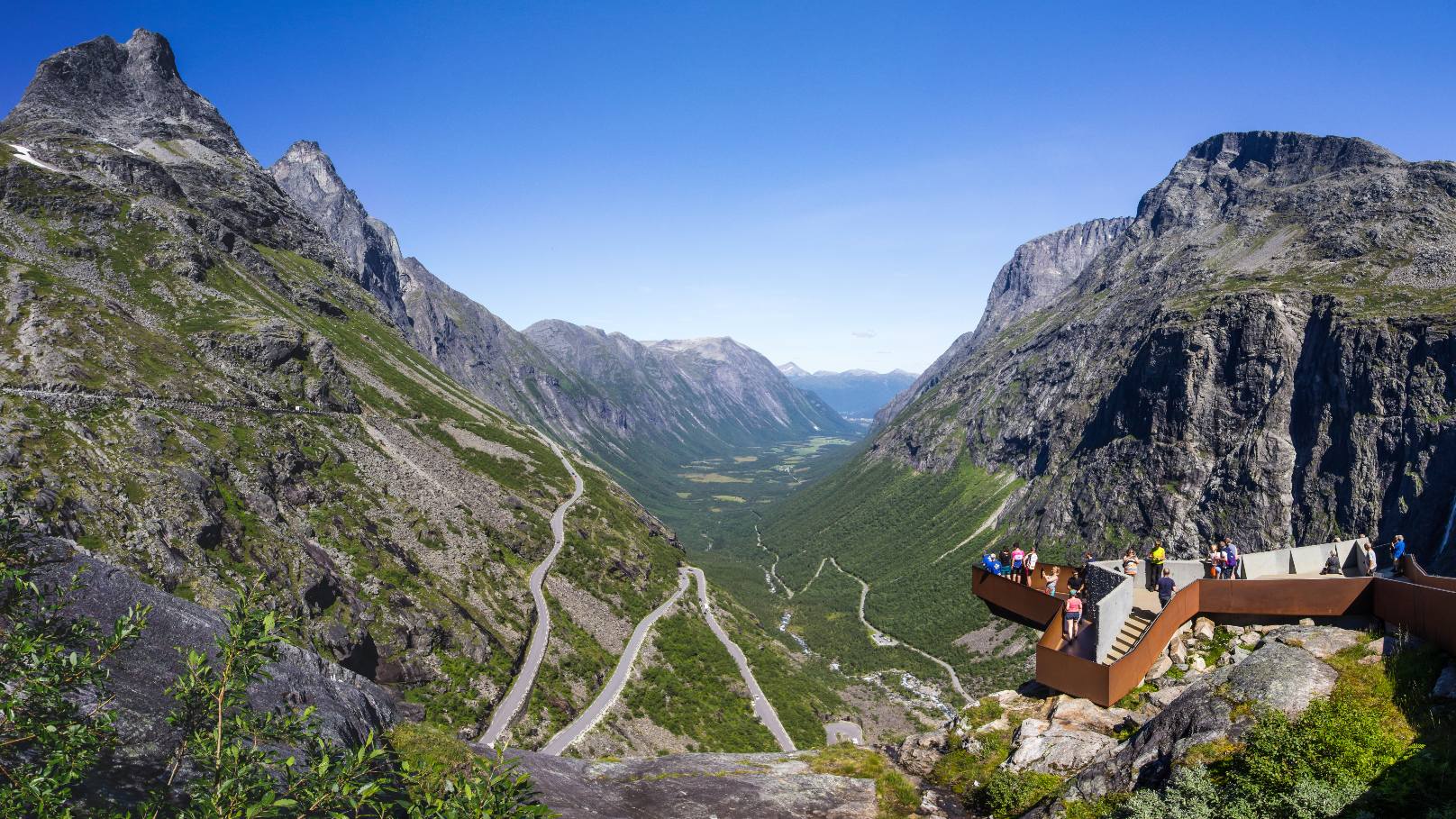
2. Sognefjord
Often called the “King of the Fjords”, Sognefjord is Norway’s longest and deepest fjord – it’s celebrated for the scale and drama of its surroundings.
The fjord’s main channel reaches over 160 kilometres (100 miles) inland. And branching off to the north and south are smaller arms, including Aurlandsfjord and Nærøyfjord.
If you want to experience Norway’s wild landscapes, then Sognefjord is one of the country’s top destinations.
Here you’ll find 2 beautiful national parks: Jotunheimen and Jostedalsbreen. Visit them and you’ll be able to hike alongside dazzling glaciers, admire towering peaks and enjoy wildlife watching.
When you’re in the region, don’t miss out on riding the Flåm railway, which climbs up to the mountain village of Myrdal. You could also head north from Flåm to visit the fjord-side Urnes Stave Church, a UNESCO-listed building dating back to the 12th century.
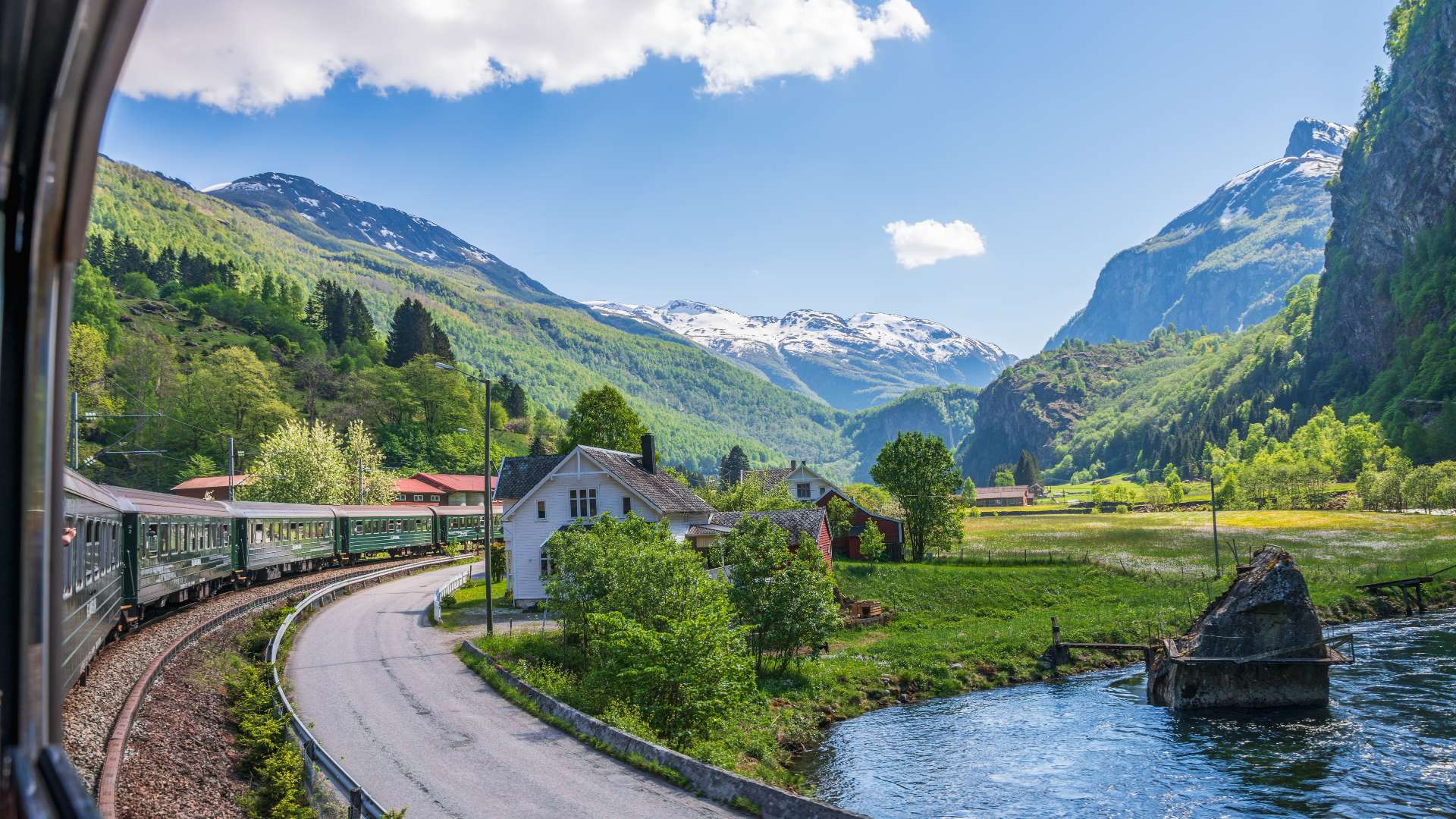
How do I get to Sognefjord?
To reach Sognefjord, it’s best to travel from Bergen, which has an airport and railway station. From Bergen, you can get to Sognefjord by any of the following means.
By car: With a rental car you could drive to Sognefjord from Bergen in around 2-3 hours, depending on your destination.
By train: The train station for the Sognefjord region is Flåm. From here you can connect to Bergen via Myrdal, which takes approximately 4 hours.
By ferry: There are daily ferries connecting Bergen to the villages along Sognefjord year-round. The return journey to Flåm on the express ferry takes about 5 hours 30 minutes.
By plane: You could also opt to travel by plane to Sogndal, where you’ll find a small regional airport. There are daily flights to Oslo and Bergen.
- Experience one of the country’s most memorable journeys on a Norway in a Nutshell® tour
- Related: Why Bergen is called the "gateway to the fjords"
3. Aurlandsfjord & Nærøyfjord
These twinned fjords are arms of the extensive Sognefjord. The eastern fork, Aurlandsfjord, which comes to an end at the village of Flåm, which is known for its steep railway (the “Flamsbana”).
Meanwhile, if you explore its western fork, Nærøyfjord, you can visit the village of Gudvangen, considered one of the most beautiful fjords in Norway. Head here, and you’ll soon see why these fjords are UNESCO-listed, along with Geirangerfjord!
Happily, Flåm and Gudvangen are connected by the Gudvangentunnelen (one of the longest road tunnels in Norway). This makes it easy to travel between them by car or bus, in just 20 minutes.
A visit to these Norwegian fjords is the perfect opportunity for a scenic ferry ride. In fact, this is one of the best cruise journeys in Norway. And year-round ferries mean that no matter when you travel, you can soak up the sights of both fjords from the comfort of a passenger boat.
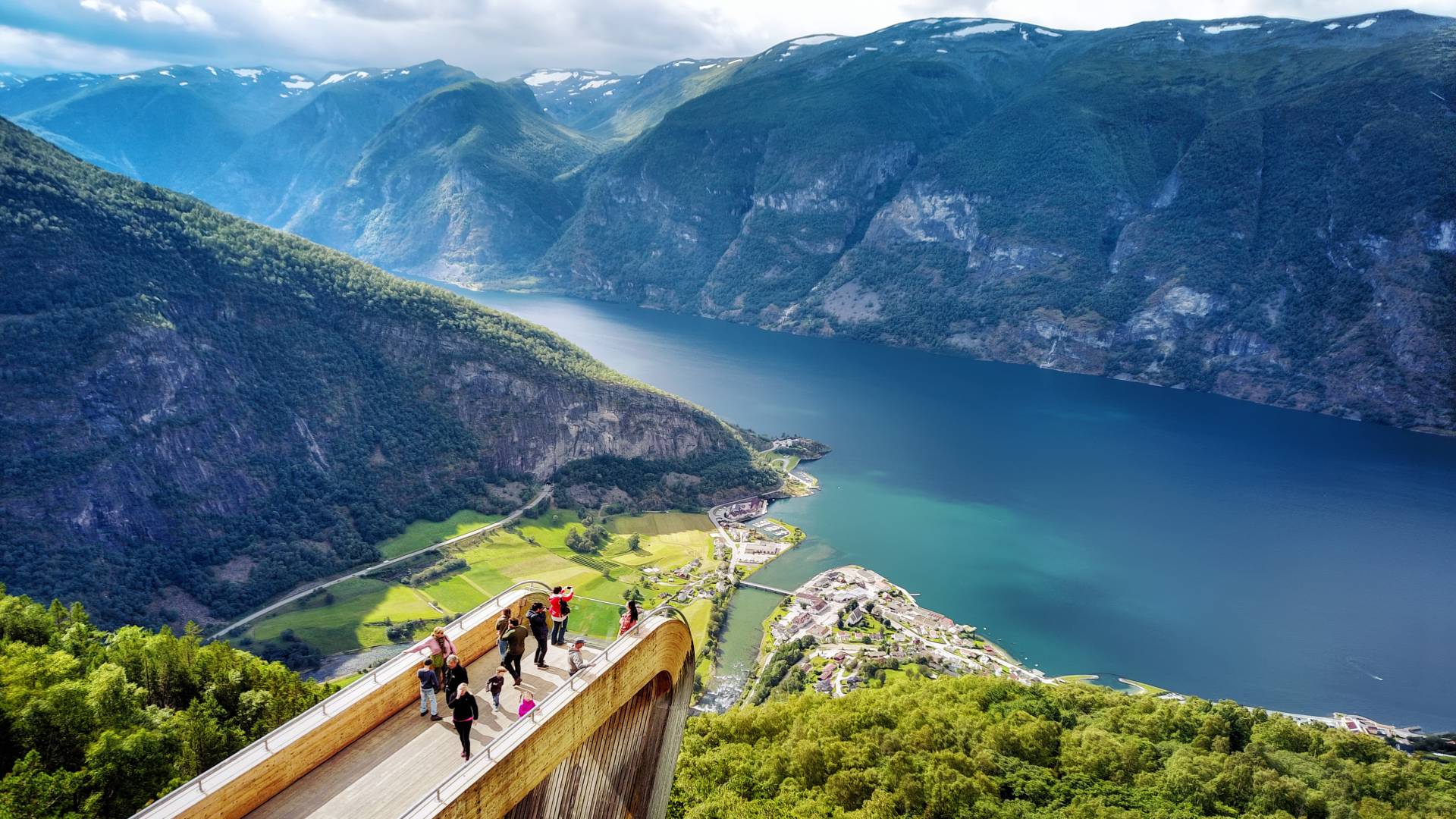
How do I get to Aurlandsfjord & Nærøyfjord?
Arrive in Bergen before travelling onto either Aurlandsfjord or Nærøyfjord by train or car.
By car: You can follow the E16 road from Bergen to Gudvangen in around 2 hours. Then from here drive through the Gudvangentunnelen and you’ll arrive in Flåm in another 20 minutes.
By train: Alternatively, catch the train from Bergen to Flåm, via the mountain station of Myrdal. This scenic rail journey takes around 4 hours.
- Discover the Norway fjords on a cruise and train trip
- Related: Norway in focus – the UNESCO-listed Nærøyfjord
4. Hardangerfjord
Hardangerfjord is one of the longest fjords in the world, and at its deepest point, it delves down to half a mile. Size aside, the fjord is known mainly for its picturesque hiking trails.
One of the most iconic walks is the one up to Trolltunga. This formidable-looking rock formation is perched 1,100 metres (3,610 feet) above sea level. So you can imagine that it affords breathtaking views over the surrounding area.
The town of Odda, found at the tip of Sørfjord, is a good base for exploring the Hardangerfjord region. You’ll find it nestled between the Folgefonna glacier and Hardangervidda National Park, a mountain plateau famed for its cycling and walking routes.
Good to know: Many of the region’s hiking trails are open from June to September. Outside of these months, the routes may be inaccessible due to snow and ice, or only possible with a guided tour.
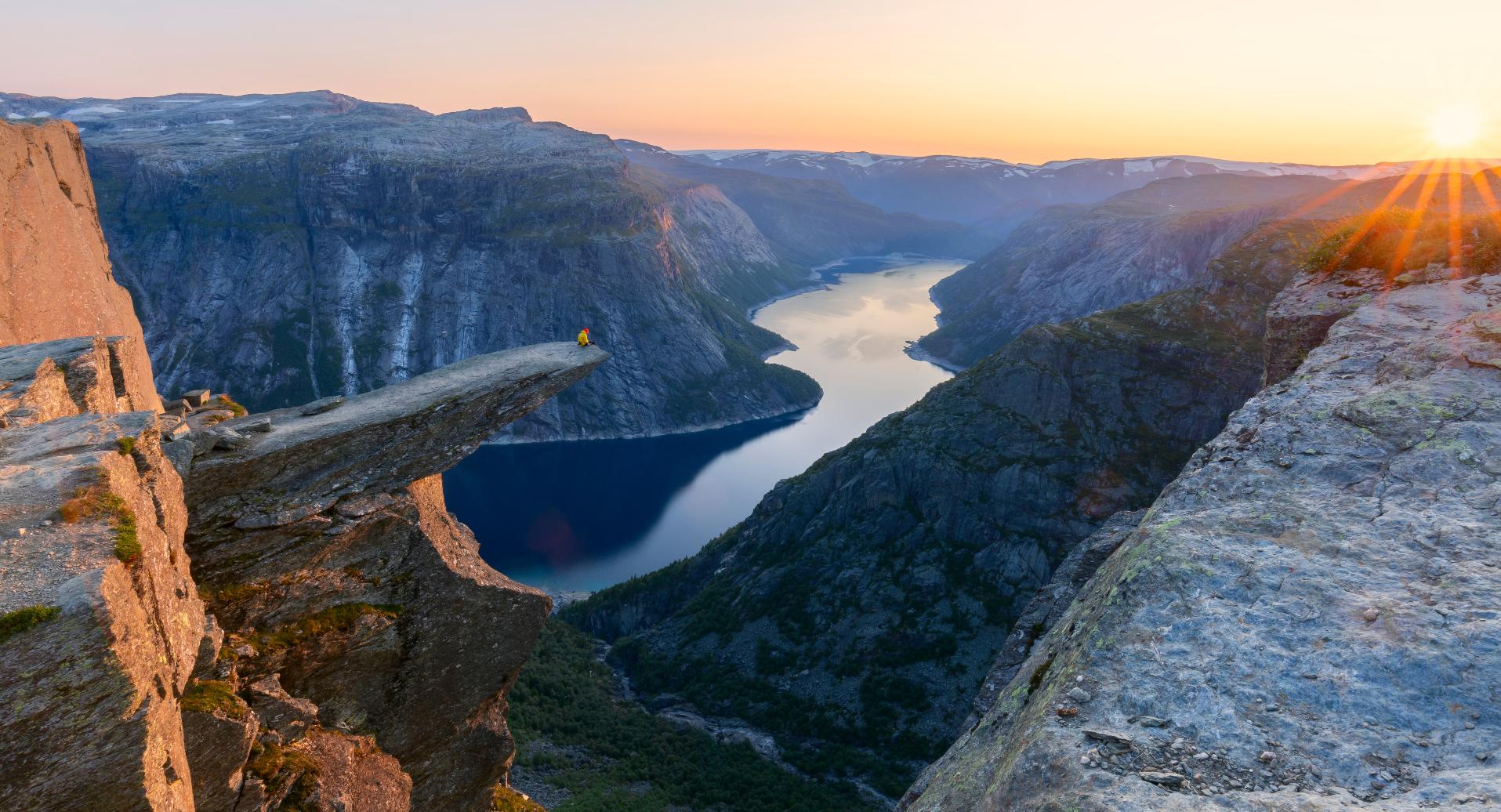
How do I get to Hardangerfjord?
Once again, you’ll find that heading to Bergen, before travelling on from there, is the easiest way to reach Hardangerfjord.
By car: You can drive from Bergen to Hardangerfjord in just over 1 hour. But it’s also possible to follow the E134 for most of the way from Oslo, which takes around 6 hours.
By bus: Alternatively, you could travel by bus from Bergen to Mundheim, on the shores of Hardangerfjord, in 1 hour 45 minutes.
By ferry: There are also year-round daily ferry departures from Bergen to Rosendal, with bus connections to the towns of Odda and Husnes. The journey to Rosendal takes 2 hours.
- A Norway summer tour is ideal for enjoying activities such as hiking
- Related: Norway’s best Instagram spots
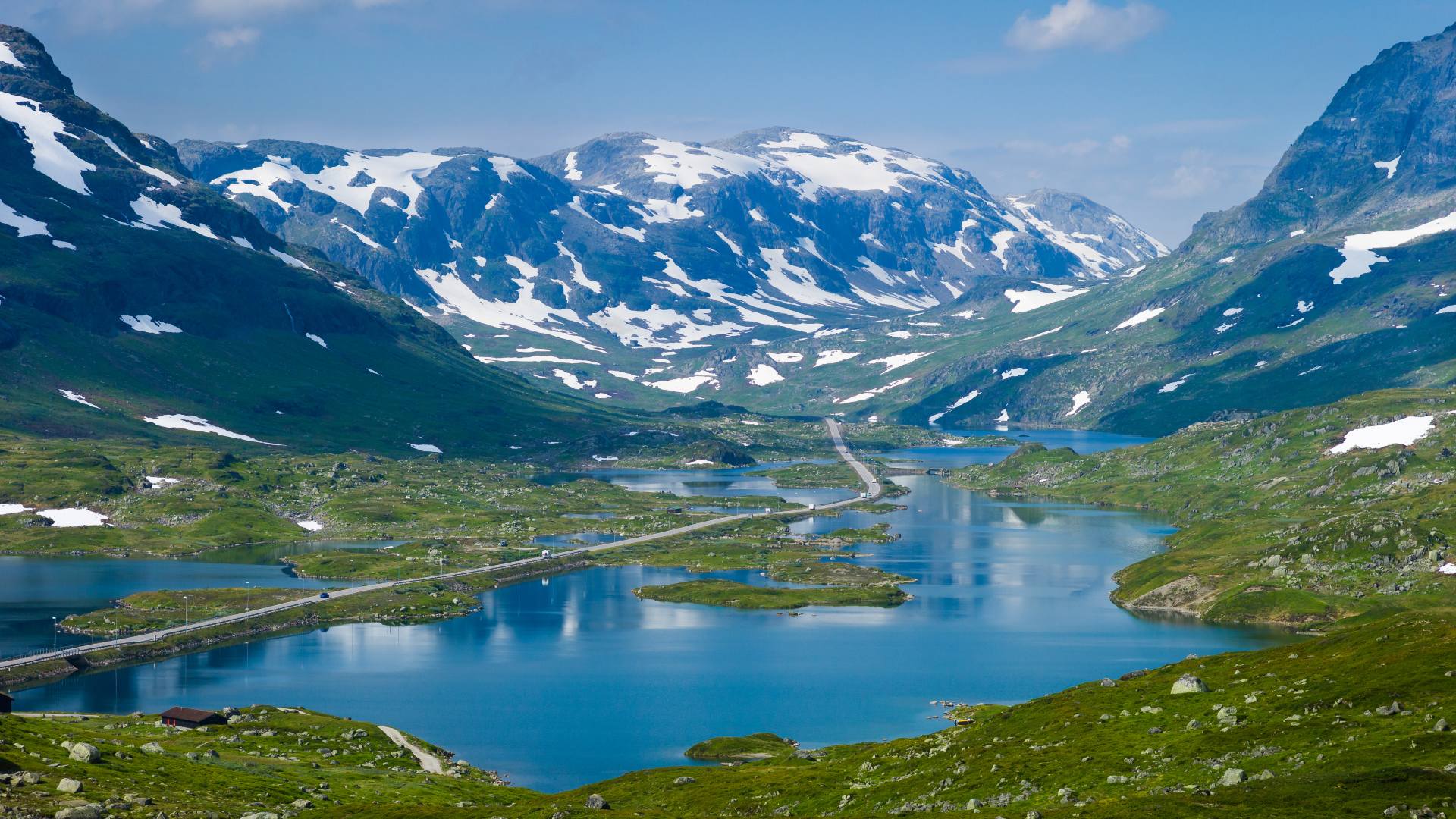
5. Lysefjord
Lysefjord is a narrow, 25-mile-long fjord situated just east of Stavanger. And it’s one of 13 regions in Norway to receive the title of Sustainable Destination, making it ideal if you’re an environmentally conscious traveller.
Do you like hiking? If so, you’ll love Lysefjord, a popular walking destination that’s home to numerous trails and lookout points, including Pulpit Rock (“Preikestolen”).
This vast square outcrop has become an iconic viewpoint in recent years. And while you’ll rarely have it to yourself, it does offer unforgettable views of Lysefjord.
Another must-see in the area is one of the world’s longest wooden staircases at Flørli. Climb the 4,444 steps and you’ll be rewarded with endless mountain views. That said, it’s worth remembering that this will be a challenging outing for most.
An excellent base for exploring Lysefjord is Forsand village, found at the entrance to the fjord. From here you can hop on a passenger ferry to either Lysebotn or Flørli.
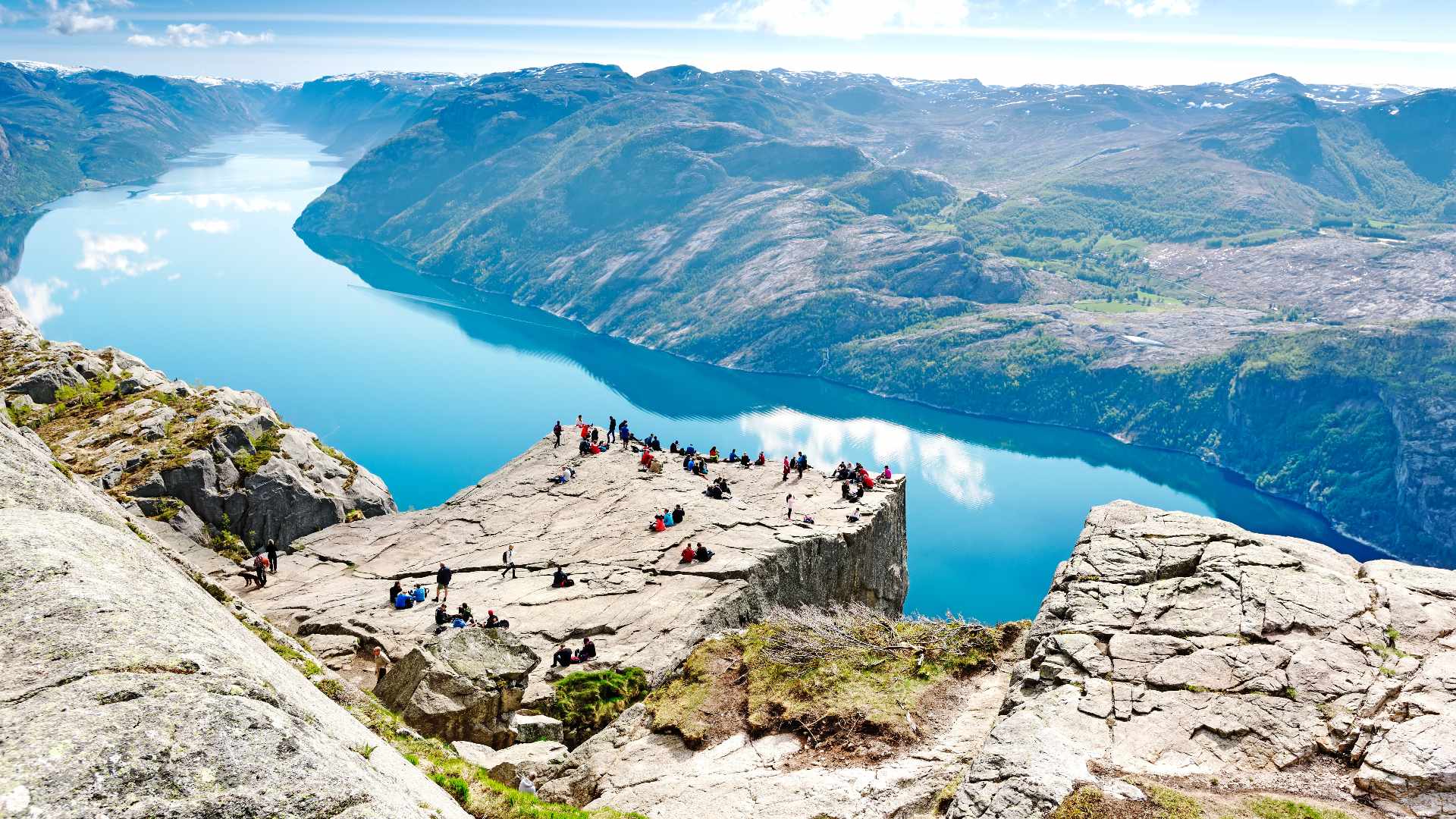
How do I get to Lysefjord?
You can get to Lysefjord by road or ferry from the city of Stavanger, which is served by an airport and train station.
By car: You can either drive from Stavanger to Tau (25 minutes) or take a car ferry (20 minutes). Then from here, drive south to Lysefjord, which takes another 20 minutes.
By bus and ferry: In summer hop on a bus or ferry from Stavanger to Tau. You can then travel onto Forsand, near the town of Lysefjord. Allowing time for the bus and ferry connections, the journey takes around 2 hours.
- Find out how you could spend 1 week in Norway
- Related: 7 Top things to do and see in Norway
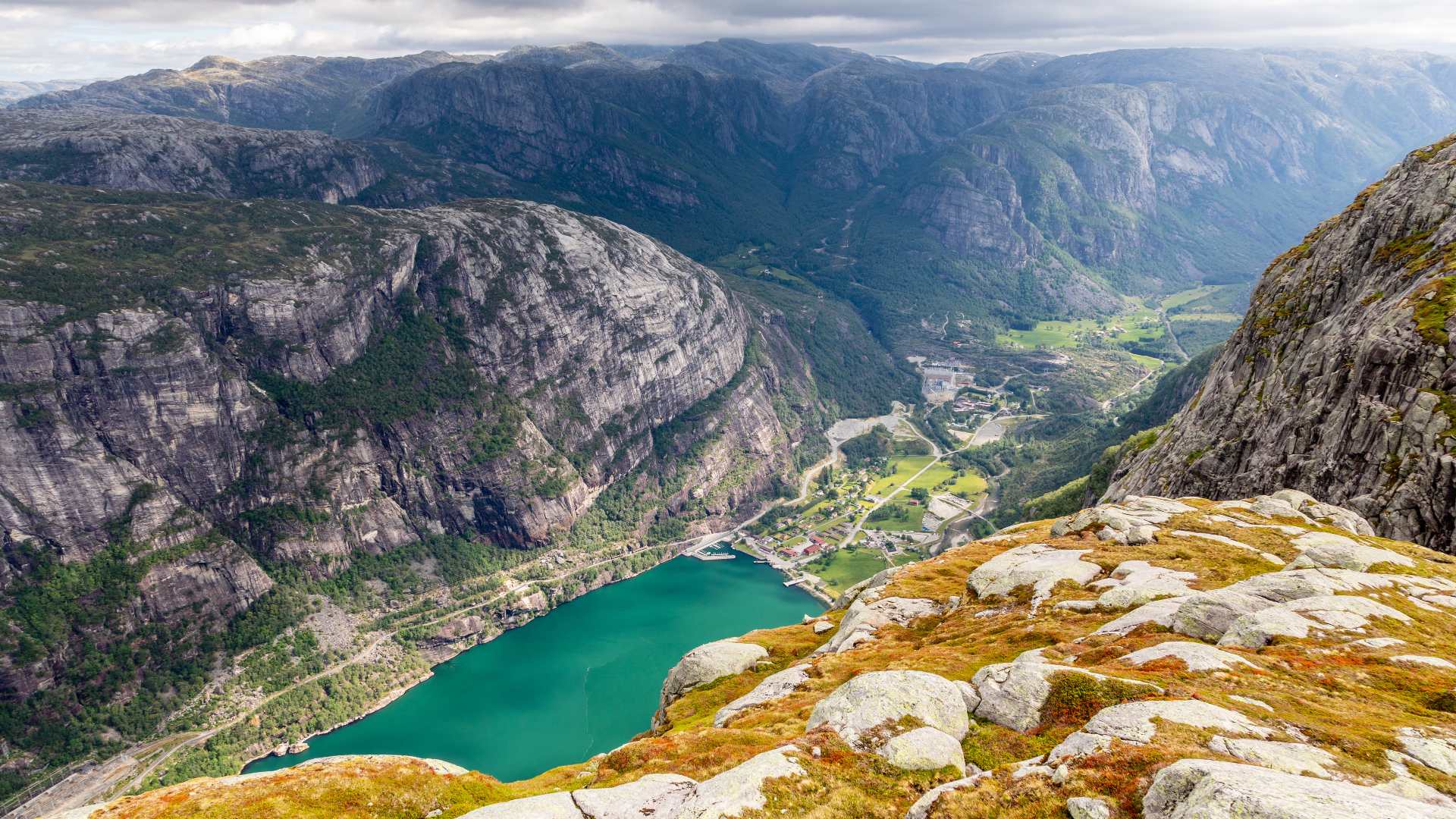
6. Trondheimsfjord
Head to Trondheim and you’ll find that it’s one of Norway’s most beautiful and historically significant cities. Indeed, the country’s former capital is where, to this day, new monarchs are blessed. Stay here, on the shores of Trondheim Fjord, and you’ll be well placed for exploring the surrounding region.
The city itself is renowned for the colourful buildings and picturesque waterways of the old quarter (“Bakklandet”). While you’re here, make sure to visit the open-air Trøndelag Folk Museum and Nidaros Cathedral, the world’s northernmost gothic cathedral.
Although there’s plenty to see and do in Trondheim itself, make sure to venture beyond the city to see the fjord itself. During the summer months, you can hop aboard one of the hourly boat trips to Munkholmen. This tiny island is home to the remains of a monastery, prison and fort.
Alternatively, you could take the ferry from Trondheim to the picturesque coastal town of Kristiansund (3 hours 30 minutes), a favourite spot for cruise ships. On the ferry, simply sit back and enjoy the majestic fjord scenery as you make your way out to sea.
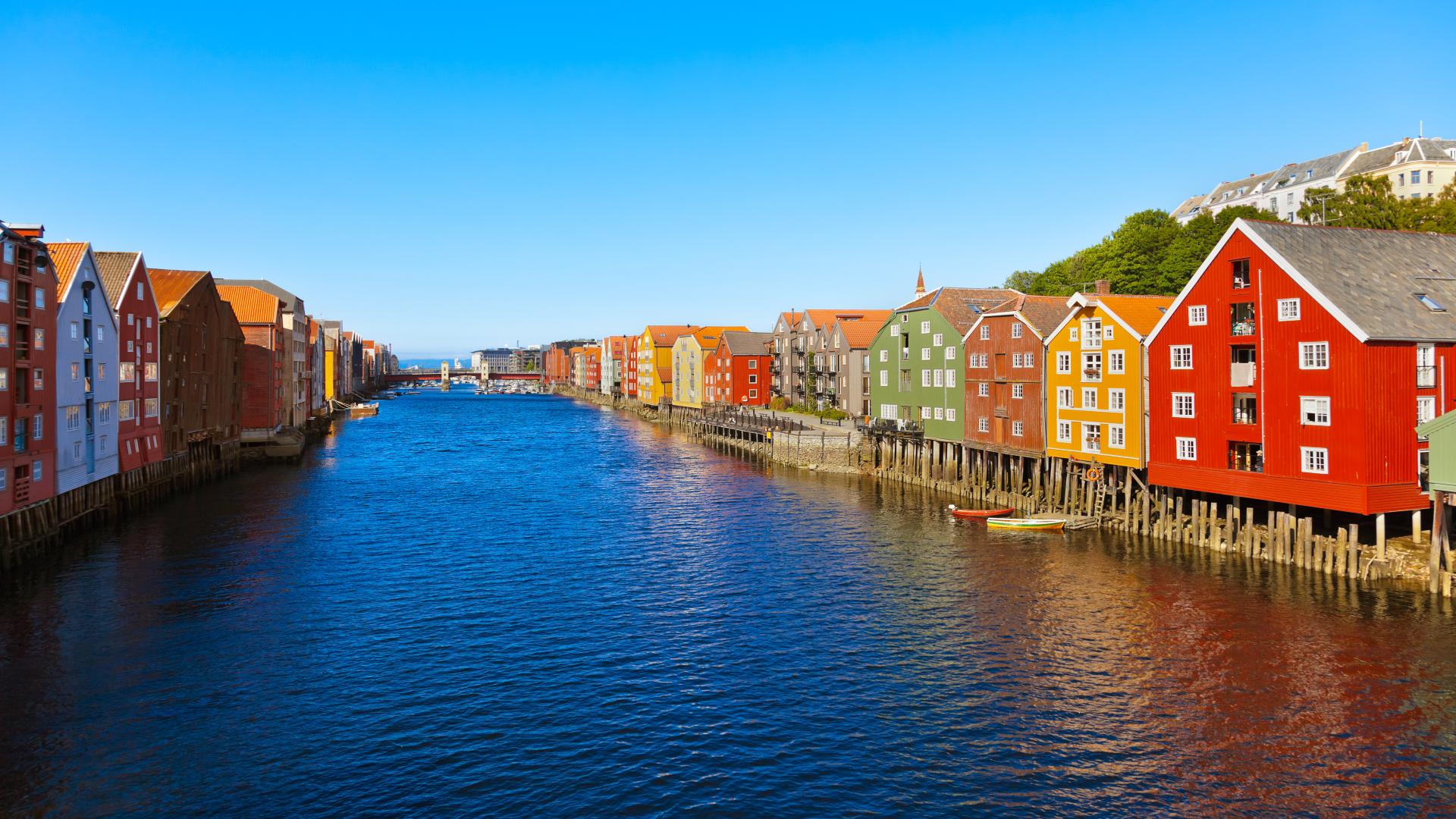
How do I get to Trondheimsfjord?
Trondheim Fjord is one of the most accessible Norway fjords. You can walk along the shores of the fjord, which are just moments away from the heart of the city.
By plane: It’s possible for you to fly to Trondheim from Oslo or Bergen in about 1 hour.
By train: Otherwise, opt to take the train from Oslo to Trondheim. This is a scenic 7-hour journey, across the country’s interior.
By car: You could also drive from Oslo to Trondheim in around 7 hours. It’s also possible to depart from Bergen. But this is a longer 10 to 12-hour drive, that’s best enjoyed as a multi-day road trip along Norway's west coast.
- Get ideas on how you can get the most out of travelling solo in Norway
7. Lofoten Islands
The Lofoten Islands may not be home to one must-see fjord, but this northern archipelago definitely merits a mention. Not only is it brimming with jaw-dropping coastal scenery, but it’s also a wishlist-worthy destination for other reasons.
For instance, head here in winter and you could chase the aurora on a Norway northern lights tour.
Or opt for a summer road trip and make the most of opportunities for mountain walks, beach strolls and even fjord kayaking. This time of year is also great for spotting local wildlife, including sea eagles, European moose, and marine mammals, such as orcas.
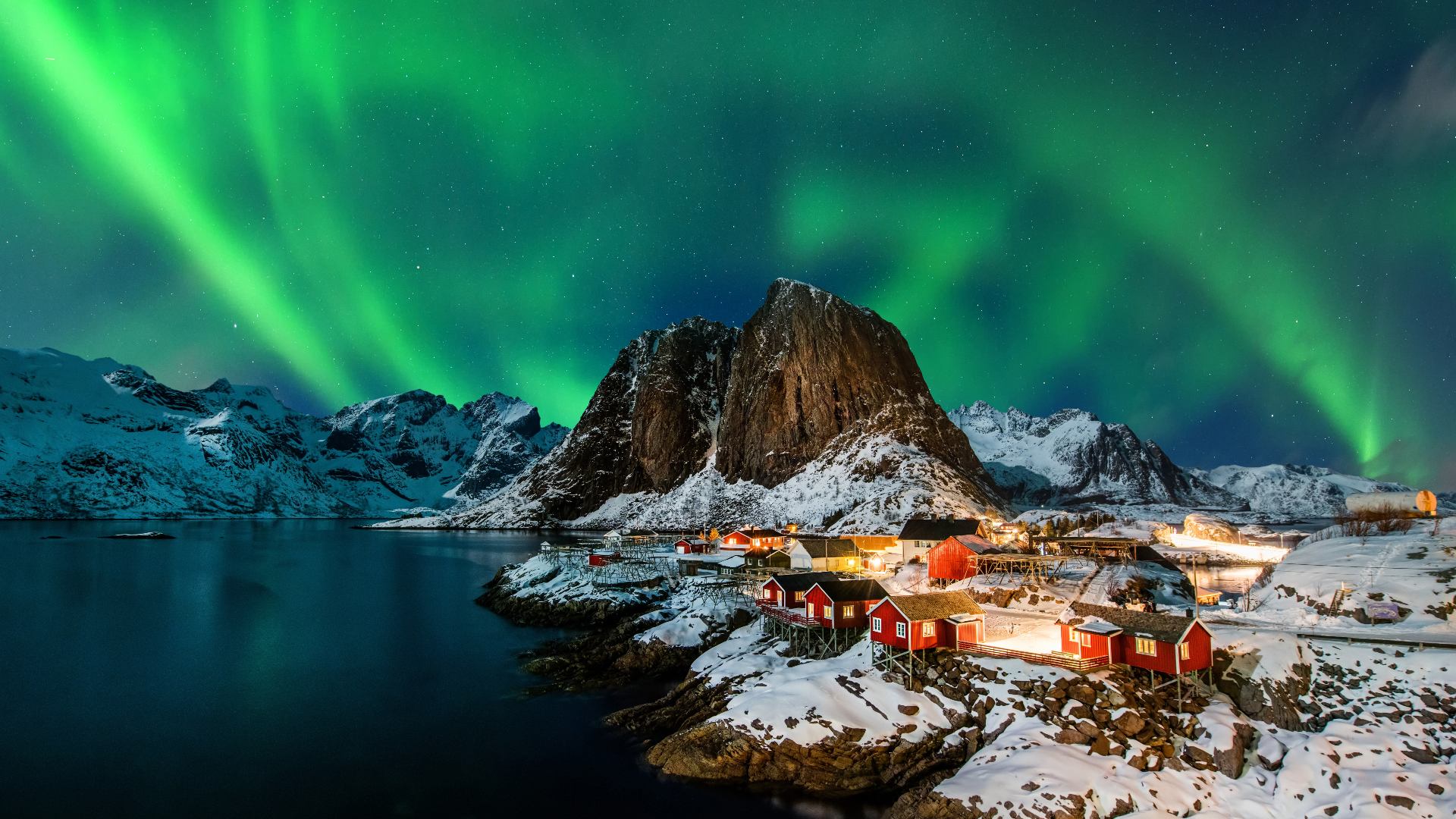
How do I get to the Lofoten Islands?
You can choose to appreciate the beauty of this archipelago on a passing Havila or Hurtigruten cruise. But if you want more time to explore the Lofoten Islands, you could hop off the ship here before rejoining the journey on another ship.
By plane: To reach Svolvær, at the northern end of the Lofoten archipelago, you can fly from Oslo via Bodø. The journey from Oslo to Bodø takes around 1 hour 30 minutes and the flight onto Svolvær takes another 25 minutes.
By ferry: It’s also possible to arrive at the southern end of the Lofoten Islands. If you’d prefer to do this, you can fly from Oslo to Bodø (1 hour 30 minutes) before taking the car ferry to Moskenes (3 hours 15 minutes). If you plan to road trip up through the island chain, it’s a good idea to pick up your rental car in Bodø.
-
Check out these expert-curated itineraries for a memorable getaway to the Lofoten Islands
- Related: Best time and place to see the northern lights in Norway
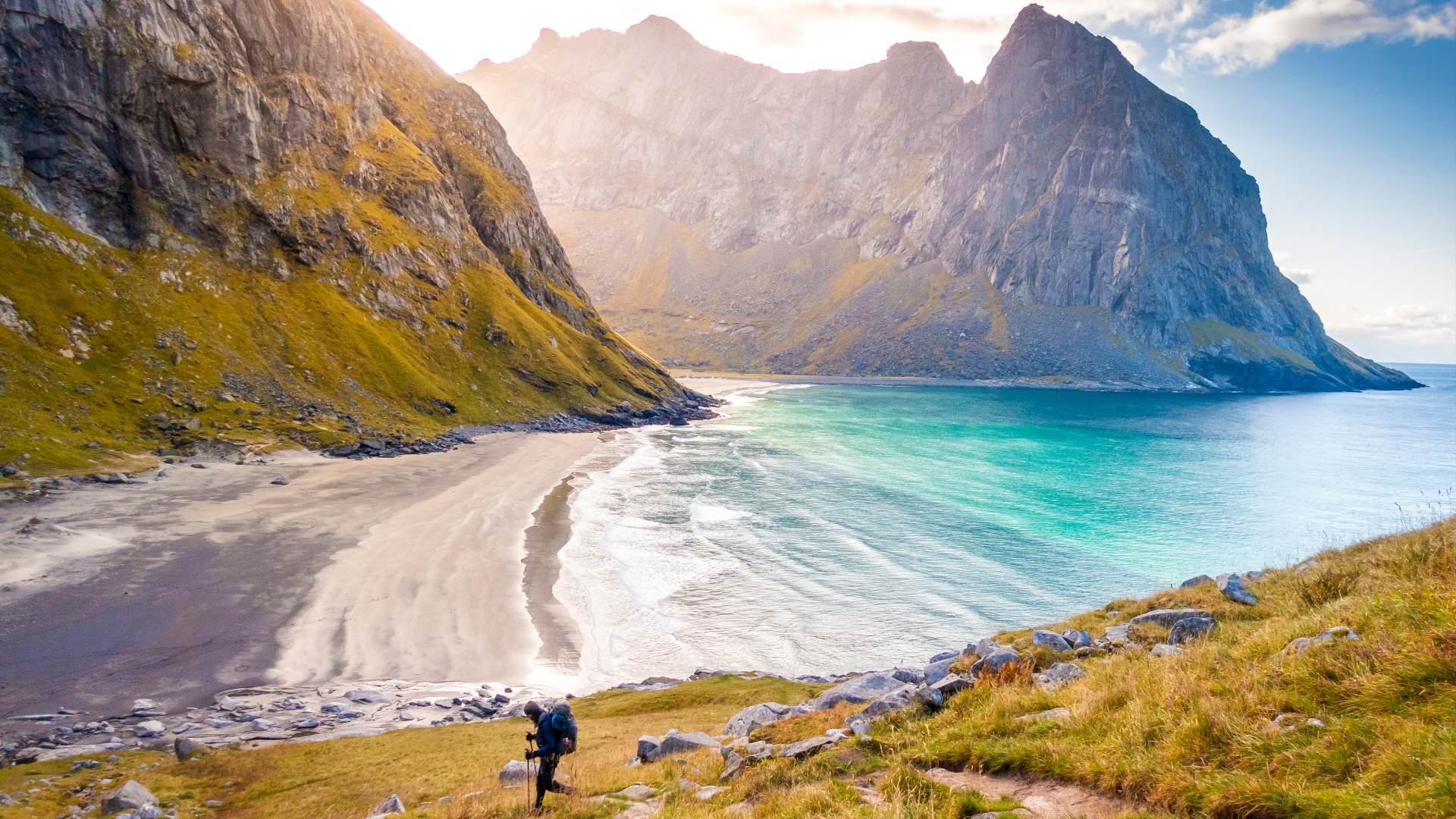
Planning your trip to the beautiful Norwegian fjords
If you’d like to experience Norway’s fjords for yourself, then what are you waiting for? Choose one of these Norwegian fjords packages and you’ll enjoy the trip of a lifetime.
Book with Nordic Visitor and all you need to do is choose the best time to visit Norway for you. Then your dedicated travel consultant, based in Scandinavia, will take care of the logistics for you.
Depending on the itinerary you pick, this includes your in-country travel tickets, accommodation and any car rental, along with some activities and meals.
With trips from just 4 days to over 3 weeks in Norway, you’ll find something to suit you. You’ll also be able to select the travel style that’s best for you. For instance, you could explore on a cruise and train journey, a self-drive trip or a guided small group tour of Norway.
Are you ready to discover Norway’s awe-inspiring fjords for yourself? If so, get in touch with us and our regional travel experts will help make your travel dreams come true.
